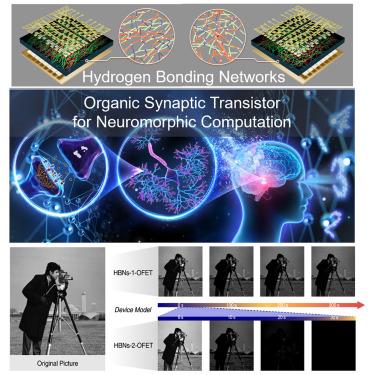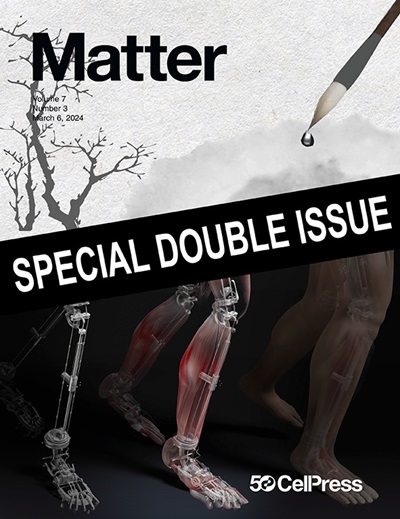Hydrogen bonding networks for tunable organic neuromorphic transistor arrays and in-sensor computing
IF 17.5
1区 材料科学
Q1 MATERIALS SCIENCE, MULTIDISCIPLINARY
引用次数: 0
Abstract
Inspired by neural architectures, synaptic transistors incorporating sensing, memory, and computing functionalities within one device have garnered widespread attention. However, achieving high carrier mobility and enduring synaptic plasticity remains challenging due to the unbalanced charge trapping effect at the dielectric/semiconductor interface. Here, introducing the hydrogen bonding networks, constructed via double dielectric materials, significantly improves the interface characteristics. This approach could modulate the carrier mobility of fabricated synaptic transistors from 0.49 to 22 cm2 V−1 s−1 and increase synaptic plasticity from 67 to 10,000 s with an ultra-low energy consumption of 24 aJ per synaptic event. Moreover, we have devised an innovative linear self-attention-based spatial and channel joint attention (LSSCA) network architecture for spiking neural networks (SNNs) that exploits synaptic transistors to enhance image classification accuracy from 76% to 99%. This study provides a direct and effective strategy for engineering optically controlled synaptic transistors that demonstrate superior carrier mobility and prolonged plasticity, promising potential in low-energy, high-precision neuromorphic applications.


用于可调谐有机神经形态晶体管阵列和传感器内计算的氢键网络
受神经结构的启发,突触晶体管在一个设备中集成了传感、记忆和计算功能,引起了广泛的关注。然而,由于介电/半导体界面上不平衡的电荷捕获效应,实现高载流子迁移率和持久的突触可塑性仍然具有挑战性。通过引入双介质材料构建的氢键网络,显著改善了界面特性。这种方法可以将制造的突触晶体管的载流子迁移率从0.49到22 cm2 V−1 s−1,并将突触可塑性从67增加到10,000 s,每个突触事件的超低能耗为24 aJ。此外,我们为尖峰神经网络(snn)设计了一种创新的基于线性自注意的空间和通道联合注意(LSSCA)网络架构,该架构利用突触晶体管将图像分类准确率从76%提高到99%。该研究为工程光控突触晶体管提供了一种直接而有效的策略,这种晶体管具有优越的载流子迁移率和长时间的可塑性,在低能量、高精度的神经形态应用中具有广阔的潜力。
本文章由计算机程序翻译,如有差异,请以英文原文为准。
求助全文
约1分钟内获得全文
求助全文
来源期刊

Matter
MATERIALS SCIENCE, MULTIDISCIPLINARY-
CiteScore
26.30
自引率
2.60%
发文量
367
期刊介绍:
Matter, a monthly journal affiliated with Cell, spans the broad field of materials science from nano to macro levels,covering fundamentals to applications. Embracing groundbreaking technologies,it includes full-length research articles,reviews, perspectives,previews, opinions, personnel stories, and general editorial content.
Matter aims to be the primary resource for researchers in academia and industry, inspiring the next generation of materials scientists.
 求助内容:
求助内容: 应助结果提醒方式:
应助结果提醒方式:


